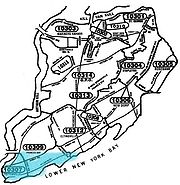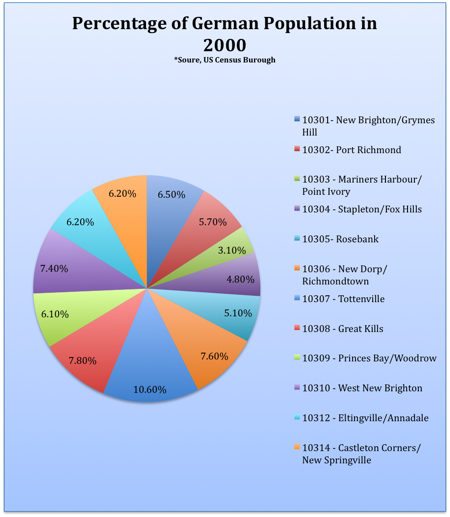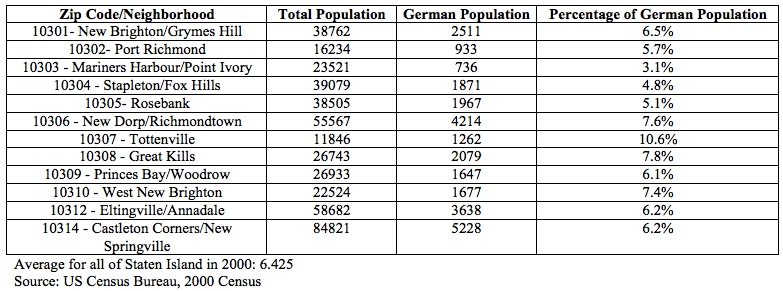From The Peopling of New York City
Contents |
Overview
According to the most recent census data, there are 27,764 German-Americans in Staten Island. The Tottenville portion of Staten Island has the highest density. On average, 6.425% of Staten Islanders are German. Some German-American institutions on Staten Island include the Nurnberger Bierhaus and Kilmeyr's Old Bavarian Inn. Two people were interviewed in the coarse of this research, both of whom came to America after WWII.
Demographics
In 2000, the population of German Americans in Staten Island was 27,764 people. The total population of Staten Island was 44,3728. Thus, 6.3 percent of the population of Staten Island was German American. Between 1990 and 2000, the population of German-Americans in Staten Island decreased by 8147 from 32936 German Americans, or a change of +24789. Compared to the entire City of New York in 2000, we had a higher percentage of German Americans. In NYC, the total population of New York City was 8,008,278 people, and the total German-American population was 255,536. Thus, 3.2 percent of the population was German American in 2000. Compared to NYC, Staten Island has 3.1 percent more German-Americans. The densest neighborhood with the highest density of German Americans in 2000 was Tottenville, in zip code 10307.As stated previously, in Staten Island, 6.3 percent of the population was German-American in 2000, which is the highest in the city when all 5 boroughs are looked at individually. In Manhattan the population is 5.6 percent, in Queens it is 3.5 percent, in Brooklyn the population was 1.6 percent, and in the Bronx it was 1.3 percent.
No information beyond 2000 exists for German-Americans in Staten Island. The American Community Survey does not think Staten Island is important enough. This creates a significant amount of difficulty for accurately discussing the current German-American population. It is most unfortunate. Because of this, the most recent information is from the 2000 census, stating that the total population of German Americans is 27,764, or 6.3 percent of the population. There is no information available to determine the change between 2000 and now, or to determine the current densest zip code, though it is more than likely that it is still Tottenville.
History
Germans have been coming to this country for decades. None of the German states initially had overseas colonies, so in 1680s the first significant groups of German immigrants arrived in the British colonies, settling primarily in New York and Pennsylvania. Immigration continued in very large numbers during the nineteenth century, with some eight million arrivals from Germany. They were pulled by the attractions of land and religious freedom, and pushed out of Europe by shortages of land and political oppression. Some German immigrants were adherents to the philosophy of anarchism. After being forced out of Germany and Britain, most arrived in 1882 and soon emerged as the leader of the movement in the United States. In November 1887, eight German anarchists were indicted for the Haymarket Bombing, Later, four of these men, August Spies, Adolph Fisher, Louis Lingg and George Engel, were sentenced to death for the crime. In 1893, the German born Governor of Illinois, John Peter Altgeld, pardoned the men still in prison, but most German-Americans were law abiding citizens. Upon the outbreak of the First World War there was a growth of German nationalism in America, especially since it was not yet clear if America would fight, or what side it would be on if it did. However, when the United States entered the conflict in 1917, the vast majority of German-Americans played their full part in the war-effort. Towns, streets and buildings with German names were renamed, and Sour Kraut was renamed Liberty Cabbage. During this period a large number of American-Germans changed their surnames in order to hide their origins. A similar pattern emerged before World War II, with pre-war groups such as the German-American Bund sprouting up to encourage such patriotism. However, when the US entered into the war, many Germans enlisted in the Armed Forces (though a small number were interned by the government). After WWII, many Germans immigrated to escape Soviet oppression. Religious differences were more enduring. Most German immigrants were Protestants, with Lutheranism by far the most denomination; perhaps a third of German immigrants were Catholics, and around 250,000 were Jewish. With the Lutheran community in the United States there was considerable friction. Nineteenth-century German Lutheran immigrants found that the existing German Lutheran churches in the US had developed into what, to them, were unwelcome tendencies. Once settled, immigrants looked for work. There were never enough jobs, and employers often took advantage of the immigrants. Men were generally paid less than other workers, and women less than men. Social tensions were also part of the immigrant experience. Often stereotyped and discriminated against, many immigrants suffered verbal and physical abuse because they were "different." While large-scale immigration created many social tensions, it also produced a new vitality in the cities and states in which the immigrants settled. The newcomers helped transform American society and culture, demonstrating that diversity, as well as unity, is a source of national strength. They are still coming into America at a fast rate looking for a better life for themselves and their family.
The People
Both people interviewed came to this country around 50 years ago, in the era just after the fall of the Third Reich. He moved directly to Staten Island. Only our first subject, Mark Brandt, allowed his name to be released or photographs to be taken.
Our second subject choose to remain anonymous. She immigrated in 1955 from East Berlin to escape communism. She moved to Brooklyn before she moved to Staten Island in 1968. She came with her husband.
(Main Article: German Interviews)
Ethnic Stages
Within Staten Island, there are two German American institutions that could be found with the resources at hand (including the use of internet search engines, the website http://www.germanyinnyc.org/, and by speaking to German-American people); both of them were privately owned restaurants, namely Killmeyer's Old Bavarian Inn and the Nurnberger Bierhaus (German for Beer House). We choose to visit and expound upon the Nurnberger Bierhaus primarily because of its convenient location and the positive feedback we had heard about the food, in addition to its apparent adherence to German culture, and the fact that we knew for a fact the owner was a German expatriate, and because a member of the staff was known personally by one of our number, providing a jumping off point to speak to the staff and owner.
(See main article, Nurnberger Bierhaus)
Readings
1. Kurthen, Hermann. Journal of Interdisciplinary History. "Germany in America." Vol. 17, No. 3 (Winter, 1987), pp. 565-585
2. Monos, Dimitris. The German Americans. New York: Chelsea House, 1988.
3. Spencer, Aaron. Hopeful journeys: German immigration, settlement, and political culture in colonial America, 1818-1905
4. Gibbons, John. Employment Effects of German Immigration to America: An Analysis Based on Local Labor Markets 1908-1919
5. Davis, Rogers. Coming to America: a history of immigration and ethnicity in American life. 2008
6. Joppke, Christian. Immigration and the nation-state: the United States and Germany. 2006
7. Kurthen, Hermann. Germany at the Crossroads: National Identity and the Challenges of Immigration. 2003
8. Veglery, Anna. Germans in New York. 1980
9. Carnevale, Nancy . A New Language, a New World: German Immigrants in the United States, 1890-1945.
10. Smith, Jacob. The Staten Island German-American Experience. New York: "German cuisine" [s.n.], 2009. Print.
11. Richards, David. German American: the Racializing of an Ethnic Identity. New York: New York UP, 2001. Print.
12. Terpstra, Nicholas. The Politics of Ritual Kinship: Confraternities and Social Order in Early Modern Germany. Cambridge: Cambridge University, 2000. Print.
13. Tomasi, Silvano. Perspectives in German Immigration and Ethnicity. New York: Center for Migration Studies, 1982. Print.
14. Allen, Louis. Changes in Social Organization: The German Immigration to America. Cambridge, Massachusetts: Harvard University, 1950.
15. Mosher, Steven. Broken Earth: The Rural Germans. New York: Free Press. 1983.



